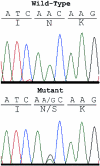A kinesin heavy chain (KIF5A) mutation in hereditary spastic paraplegia (SPG10)
- PMID: 12355402
- PMCID: PMC385095
- DOI: 10.1086/344210
A kinesin heavy chain (KIF5A) mutation in hereditary spastic paraplegia (SPG10)
Abstract
We have identified a missense mutation in the motor domain of the neuronal kinesin heavy chain gene KIF5A, in a family with hereditary spastic paraplegia. The mutation occurs in the family in which the SPG10 locus was originally identified, at an invariant asparagine residue that, when mutated in orthologous kinesin heavy chain motor proteins, prevents stimulation of the motor ATPase by microtubule-binding. Mutation of kinesin orthologues in various species leads to phenotypes resembling hereditary spastic paraplegia. The conventional kinesin motor powers intracellular movement of membranous organelles and other macromolecular cargo from the neuronal cell body to the distal tip of the axon. This finding suggests that the underlying pathology of SPG10 and possibly of other forms of hereditary spastic paraplegia may involve perturbation of neuronal anterograde (or retrograde) axoplasmic flow, leading to axonal degeneration, especially in the longest axons of the central nervous system.
Figures



Comment in
-
Is the transportation highway the right road for hereditary spastic paraplegia?Am J Hum Genet. 2002 Nov;71(5):1009-16. doi: 10.1086/344206. Epub 2002 Sep 24. Am J Hum Genet. 2002. PMID: 12355399 Free PMC article. Review.
References
Electronic-Database Information
-
- EMBL-EBI European Bioinformatics Institute, http://www.ebi.ac.uk/clustalw/ (for ClustalW)
-
- UCSC Genome Bioinformatics, http://genome.cse.ucsc.edu/ (for working draft human genome sequence database)
References
-
- Ashley-Koch A, Bonner ER, Gaskell PC, West SG, Tim R, Wolpert CM, Jones R, Farrell CD, Nance M, Svenson IK, Marchuk DA, Boustany RM, Vance JM, Scott WK, Pericak-Vance MA (2001) Fine mapping and genetic heterogeneity in the pure form of autosomal dominant familial spastic paraplegia. Neurogenetics 3:91–97 - PubMed
-
- Errico A, Ballabio A, Rugarli, EI (2002) Spastin, the protein mutated in autosomal dominant hereditary spastic paraplegia, is involved in microtubule dynamics. Hum Mol Genet 11:153–163 - PubMed
-
- Fink JK (2002) Hereditary spastic paraplegia: the pace quickens. Annals of Neurology 51:669–672 - PubMed
-
- Goldstein LSB, Yang Z (2000) Microtubule-based transport systems in neurons: the roles of kinesins and dynamins. Annu Rev Neurosci 23:39–71 - PubMed
Publication types
MeSH terms
Substances
Associated data
- Actions
- Actions
- Actions
- Actions
- Actions
- Actions
- Actions
- Actions
- Actions
Grants and funding
LinkOut - more resources
Full Text Sources
Other Literature Sources
Molecular Biology Databases

